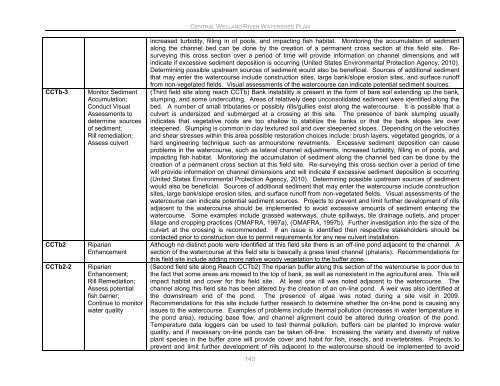Central Welland River Watershed Plan - Niagara Peninsula ...
Central Welland River Watershed Plan - Niagara Peninsula ...
Central Welland River Watershed Plan - Niagara Peninsula ...
- No tags were found...
Create successful ePaper yourself
Turn your PDF publications into a flip-book with our unique Google optimized e-Paper software.
CCTb-3CCTb2CCTb2-2Monitor SedimentAccumulation;Conduct VisualAssessments todetermine sourcesof sediment;Rill remediation;Assess culvertRiparianEnhancementRiparianEnhancement;Rill Remediation;Assess potentialfish barrier;Continue to monitorwater qualityCENTRAL WELLAND RIVER WATERSHED PLANincreased turbidity, filling in of pools, and impacting fish habitat. Monitoring the accumulation of sedimentalong the channel bed can be done by the creation of a permanent cross section at this field site. Resurveyingthis cross section over a period of time will provide information on channel dimensions and willindicate if excessive sediment deposition is occurring (United States Environmental Protection Agency, 2010).Determining possible upstream sources of sediment would also be beneficial. Sources of additional sedimentthat may enter the watercourse include construction sites, large bank/slope erosion sites, and surface runofffrom non-vegetated fields. Visual assessments of the watercourse can indicate potential sediment sources.(Third field site along reach CCTb) Bank instability is present in the form of bare soil extending up the bank,slumping, and some undercutting. Areas of relatively deep unconsolidated sediment were identified along thebed. A number of small tributaries or possibly rills/gullies exist along the watercourse. It is possible that aculvert is undersized and submerged at a crossing at this site. The presence of bank slumping usuallyindicates that vegetative roots are too shallow to stabilize the banks or that the bank slopes are oversteepened. Slumping is common in clay textured soil and over steepened slopes. Depending on the velocitiesand shear stresses within this area possible restoration choices include: brush layers, vegetated geogrids, or ahard engineering technique such as armourstone revetments. Excessive sediment deposition can causeproblems in the watercourse, such as lateral channel adjustments, increased turbidity, filling in of pools, andimpacting fish habitat. Monitoring the accumulation of sediment along the channel bed can be done by thecreation of a permanent cross section at this field site. Re-surveying this cross section over a period of timewill provide information on channel dimensions and will indicate if excessive sediment deposition is occurring(United States Environmental Protection Agency, 2010). Determining possible upstream sources of sedimentwould also be beneficial. Sources of additional sediment that may enter the watercourse include constructionsites, large bank/slope erosion sites, and surface runoff from non-vegetated fields. Visual assessments of thewatercourse can indicate potential sediment sources. Projects to prevent and limit further development of rillsadjacent to the watercourse should be implemented to avoid excessive amounts of sediment entering thewatercourse. Some examples include grassed waterways, chute spillways, tile drainage outlets, and propertillage and cropping practices (OMAFRA, 1997a), (OMAFRA, 1997b). Further investigation into the size of theculvert at the crossing is recommended. If an issue is identified then respective stakeholders should becontacted prior to construction due to permit requirements for any new culvert installation.Although no distinct pools were identified at this field site there is an off-line pond adjacent to the channel. Asection of the watercourse at this field site is basically a grass lined channel (phalaris). Recommendations forthis field site include adding more native woody vegetation to the buffer zone.(Second field site along Reach CCTb2) The riparian buffer along this section of the watercourse is poor due tothe fact that some areas are mowed to the top of bank, as well as nonexistent in the agricultural area. This willimpact habitat and cover for this field site. At least one rill was noted adjacent to the watercourse. Thechannel along this field site has been altered by the creation of an on-line pond. A weir was also identified atthe downstream end of the pond. The presence of algae was noted during a site visit in 2009.Recommendations for this site include further research to determine whether the on-line pond is causing anyissues to the watercourse. Examples of problems include thermal pollution (increases in water temperature inthe pond area), reducing base flow, and channel alignment could be altered during creation of the pond.Temperature data loggers can be used to test thermal pollution, buffers can be planted to improve waterquality, and if necessary on-line ponds can be taken off-line. Increasing the variety and diversity of nativeplant species in the buffer zone will provide cover and habit for fish, insects, and invertebrates. Projects toprevent and limit further development of rills adjacent to the watercourse should be implemented to avoid143
















